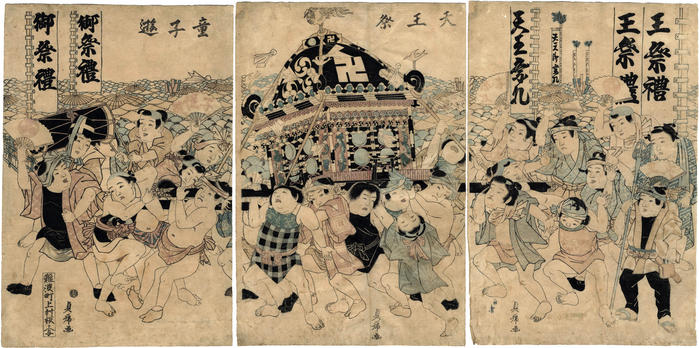Utagawa Sadafusa (歌川貞房) (artist )
Children's parade (子進) carrying a sacred float during the Tennō Festival (天王祭)
ca 1830
30 in x 15 in (Overall dimensions) Japanese color woodblock print
Signed: Sadafusa ga (貞房画)
Publisher: Uemura Yohei (Marks 564 - seal not listed)
Censor's seal: kiwame
Edo-Tokyo Museum - Tenno Festival procession by Yoshiiku Holidays which we celebrate today, are often so far removed from their original meaning, that there are few if any who could tell us how or why they were celebrated originally. Even then, we have to rely on experts to explain them, but the experts don't always agree and where does that leave us? Compound this situation with the fact that most of us learn about the externalized manifestations of holidays and/or religious festivals as children long before we can understand the fine points of each of them and we are often left with a basically meaningless muddle which can either be expressed with solemnity or frivolity or some variation in between. That is why a triptych, like the one shown on this page, is always somewhat joyful at first glance: children doing what grown up are usually left to do.
Some historical background
According to A Popular Dictionary of Shinto by Brian Bocking it says on page 202:
"Tennō [In the first of two definitions] 'Heavenly king'. An epithet of Taoist origin traditionally applied to kami or Buddhist divinities; in a Shintō context it almost always means Gozu Tennō. This is the popular 'Buddhist' name of kami Susano-o-no-mikoto, tutelary deity of the Gion shrine (or Yasaka-jinja, Kyōto) who is regarded as a gongen of Yakushi-nyorai the healing Buddha and therefore a protector against disease."
Later the author wrote:
"Tennō matsuri A summer festival traditionally held at shrines dedicated to Gozu tennō or Gion. These used to be wide-spread in Japan but appear either to have declined or been renamed gion matsuri since the Meiji period. There is a surviving tennō matsuri (also known as Tsushima matsuri) held at the Tsushima jinja in Aichi on the fourth weekend of July. It features a flotilla of towering, wide 'danjiri' boats...which float down the Tennō-gawa river on the evening before the main festival day."
Earlier on page 34 Bocking had noted: "The Gion matsuri or Gion-e was originally a Buddhist goryō-e held to dispel pestilence. It is said to have been first performed on the orders of emperor Seiwa in 869 but started as an annual festival of the capital a century later during the Enyū era, 969-984. It was discontinued in the fourteenth century but revived in the ninth year of Meiō, 1500. After the Meiji restoration the festival was conducted as a wholly Shintō affair, though it still incorporated Buddhist themes."
****
The Dictionnaire historique du Japon, Année 1993, 19 (T), says [in translation] on pages 80-81:
"This belief is particularly directed at Gozu tennō (牛頭天王), the ox-headed heavenly king. As Buddhism spread, beliefs about the various deities in its pantheon became more widespread. Among them was Gozu tennō, the protective deity of the Buddha's preaching garden, Jetavanavihāra (Gion shōja...). He was the object of a belief that considered him both a deity who brought illness (kōekishin 行疫神) and one who could also drive it away (joekishin 除疫神). This belief incorporated many elements from the path of yin and yang (ōmmyō-dō 陰陽道) and another set of beliefs, those relating to the spirits of the dead (goryō 御霊) prey to resentment. This deity was later likened to the god Susanoo (素戔嗚尊) according to the interpretation of the honji suijaku (本地垂迹)."
"Shrines in his honor are found throughout Japan, but the most famous and undisputed is the one in Kyoto, known since Meiji as Yasaka Shrine (八坂神社). From the second half of the 10th century, ceremonies were held there in honor of the spirits of the deceased (Goryō-e (御霊会), here called Gion-e (祇園会) or Gion matsuri (祇園祭) from the ancient name of this shrine, Gion-sha (祇園社). A ceremony intended to protect the city from epidemics, this festival has become, over the centuries, the great summer festival of Kyoto and one of its symbols."
"This type of festival is found in many cities throughout Japan, including the Tennō Matsuri (天王祭) at Tsushima Shrine (Tsushima-jinja 津岛神社) in Owari."
mitate-e (見立て絵) (genre)
Historical - Social - Ephemera (genre)
Uemura Yohei (上村与兵衛) (publisher)
